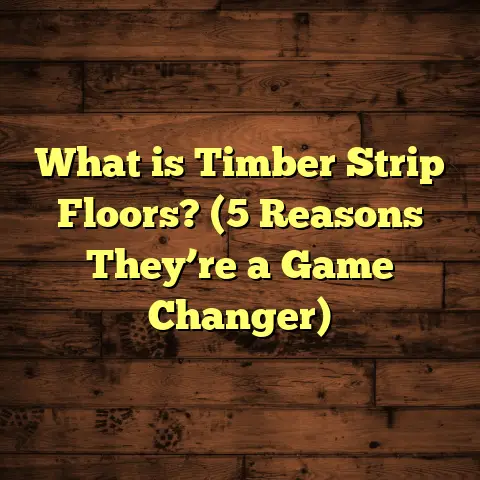What is Pergo Flooring Made Of? (5 Key Materials Explained)
When I first started working with Pergo flooring back in the early 2000s, I quickly noticed something about it that made it stand out from other budget-friendly flooring options. It wasn’t just affordable; it was also incredibly well-engineered. Over the years, I’ve installed Pergo flooring in all kinds of homes—tiny apartments in New York City, sprawling suburban houses outside Atlanta, and even vacation homes up in Colorado. And through all those projects, one thing became clear: Pergo’s success hinges on what it’s made of.
If you’re trying to pick a floor that fits your budget, looks great, and holds up well over time, Pergo is often near the top of the list. But have you ever stopped to wonder what exactly goes into Pergo that makes it such a popular choice? Let me take you through the five key materials that make up Pergo flooring and share some insights from my experience installing and living with it.
How Budget Shapes Flooring Choices
I always start conversations about flooring with a talk about budget. It’s one of those things that can make or break a project. When someone calls me asking for recommendations, they usually have a rough figure in mind for how much they want to spend per square foot.
For instance, a couple of years ago, I worked on a remodeling project in Dallas where the clients wanted to replace carpet throughout their 1,500-square-foot home. They had a budget of around $8 per square foot for materials and installation combined. After crunching numbers and exploring options, we settled on Pergo laminate flooring.
Here’s why: The Pergo materials cost about $3.50 per square foot locally in Dallas, and labor was around $4.50 per square foot. This meant they got a durable, stylish floor for their whole house within budget—and the installation took only three days total. Compare that to hardwood floors, which would’ve been well over $10 per square foot for materials alone, plus a longer installation time stretching into a week or more.
In my experience, Pergo hits a sweet spot between affordability and quality. But what exactly allows it to be both cost-effective and durable? It starts with the materials inside each plank.
1. High-Density Fiberboard (HDF) Core — The Backbone
Think of the HDF core as the skeleton of Pergo flooring. This layer provides the bulk of its strength and stability. When I first started installing laminate floors more than 15 years ago, the fiberboard cores were often less dense and prone to swelling if exposed to moisture. But Pergo has refined its core technology so much that it’s now one of the best on the market.
Typically, Pergo uses high-density fiberboard (HDF) made from compressed wood fibers mixed with resins. The fibers are pressed under high pressure and heat to create a dense panel typically 8 to 12 millimeters thick—that’s roughly half an inch or slightly less.
Why does density matter? Well, denser fiberboard is stronger and less likely to warp or dent under pressure. For comparison, medium-density fiberboard (MDF) has a density of about 600 kg/m³, while Pergo’s HDF core usually clocks in at around 900 kg/m³ or more. That extra density means better durability.
I once had a client in Minnesota who spilled a large bucket of water on their Pergo floor—an accident that would have ruined cheaper laminate floors. Because of the dense HDF core combined with moisture-resistant coatings (which I’ll cover later), the floor barely showed any signs of damage after drying out.
How HDF Core Thickness Affects Performance
Thickness matters here too. Thicker planks offer more stability and sound insulation but can be heavier and more expensive.
I recall working on a luxury condo project in Miami where the client wanted quiet floors with minimal “hollow” sound when walking on them. We used Pergo planks with a 12mm core rather than the standard 8mm. The difference was noticeable—the thicker core absorbed sound better and felt more solid underfoot.
In contrast, thinner cores (around 6-7 mm) are usually found in budget laminate brands and tend to flex more, which can lead to faster wear or even cracking if installed improperly.
Environmental Impact of HDF
One thing many people don’t realize is that HDF production can impact sustainability. Fortunately, Pergo sources much of its wood fiber from responsibly managed forests in Scandinavia and North America. Also, some mills use recycled wood fibers from sawmills or wood waste.
If you care about eco-friendliness alongside durability and price, this is an important factor. I always recommend asking your supplier about the origin of their HDF core material.
2. Decorative Print Layer — Style Meets Technology
This is where the magic happens visually. The decorative print layer is a high-resolution image printed directly onto the HDF core that simulates natural wood grain or stone textures.
When my clients see this layer up close for the first time, many are surprised how realistic the patterns look—especially at normal viewing distance.
Pergo uses cutting-edge digital printing technology capable of reaching resolutions up to 600 dots per inch (DPI). That’s similar to what you’d find in professional photo printers.
Variety and Customization
What’s cool is that this print layer isn’t just limited to wood looks. Over the years, I’ve installed Pergo floors with everything from classic oak and hickory prints to exotic bamboo patterns and even stone-like designs that mimic slate or ceramic tile.
One memorable project was a beachfront home renovation in San Diego where we installed Pergo with a driftwood-inspired print for a coastal vibe. The client loved how it captured natural variations in color and texture.
Durability of Print Layers
The print layer itself doesn’t offer protection—it’s purely aesthetic—but it’s sealed underneath the wear layer (which I’ll get into next). This seal helps keep colors vibrant over time.
Sunlight exposure can still affect colors over many years though. In rooms with large south-facing windows, I recommend UV-protective window films or curtains to extend the life of your floor’s look.
Trends I’ve Seen
Over my career, I’ve noticed shifts in popular styles tied directly to this print layer technology:
- Early 2000s: Glossy finishes with very repetitive grain patterns.
- 2010s: More matte finishes with embossed textures matching the print.
- Current trends: Wide planks with hand-scraped or wire-brushed surface textures for authenticity.
If you want your floor to look modern but not trendy for just a year or two, pay attention to these trends when choosing your Pergo design.
3. Wear Layer — Protecting Your Investment
Most people think about flooring durability only after they start seeing scratches or stains appear—and by then it’s often too late.
That’s why I always stress the importance of this wear layer on top of Pergo’s decorative print layer.
This transparent layer is made from tough melamine resin—a plastic polymer known for high scratch resistance and chemical stability.
Thickness Matters
The wear layer thickness varies by product line but usually ranges from 0.3 mm on economy models to 0.7 mm or more on premium residential products. Commercial-grade Pergo can even reach 1.2 mm thickness for heavy foot traffic areas like retail stores or offices.
Here’s what those thicknesses mean in real life:
- 0.3 mm wear layer: Suitable for light residential use like bedrooms or guest rooms.
- 0.5–0.7 mm wear layer: Ideal for kitchens, living rooms, and hallways with moderate traffic.
- 1.0+ mm wear layer: Best for commercial or very high-traffic residential settings.
I recently replaced flooring in an office space in Chicago where they opted for a commercial-grade Pergo with a 1.2 mm wear layer—it still looked great after three years despite thousands of footsteps daily.
Scratch and Stain Resistance
The melamine resin used here also offers good resistance against household chemicals like vinegar or wine stains—which I’ve personally tested during family gatherings when spills are inevitable!
From my experience installing floors for families with kids and pets, this wear layer helps maintain appearance even under some rough treatment.
Surface Textures & Finish
Another factor tied to wear layers is surface finish—matte vs gloss vs semi-gloss—and textures such as embossed wood grain or smooth surfaces.
Embossed textures combined with thicker wear layers do a better job hiding minor scratches compared to smooth finishes.
4. Backing Layer — Stability and Moisture Resistance
Often overlooked but crucial is the backing layer on the underside of each plank.
It serves two main purposes:
- Acts as a moisture barrier preventing water vapor from entering the HDF core.
- Adds dimensional stability by preventing warping or cupping after installation.
Material Composition
This backing is typically made from melamine or resin-based materials similar to the wear layer but engineered for moisture resistance rather than abrasion resistance.
Thickness ranges between 1 millimeter up to about 2 millimeters depending on product lines.
Why It Matters for Installation Locations
I’ve installed Pergo floors in basements where moisture is always a concern due to concrete slabs or nearby water sources like laundry rooms.
Without this backing layer functioning properly, moisture would seep upward causing swelling or buckling over time.
In one project in Portland, Oregon—known for damp climate—we installed an additional vapor barrier underneath before laying down Pergo planks with standard backing layers as an extra precaution.
5. Click Lock System — The Secret Behind Easy Installation
While not a raw material like the others, no discussion about Pergo would be complete without mentioning its patented click lock system—the engineered mechanism allowing planks to snap together easily without glue or nails.
How It Works
Each plank has precision-molded edges embedded with plastic locking strips reinforced internally by fiber components during manufacturing.
When connecting two boards, these strips interlock tightly creating a strong seam that keeps planks aligned while allowing slight expansion/contraction due to temperature changes.
Why It Saves Time and Money
In nearly every installation project I’ve worked on involving Pergo flooring, this system cuts down installation time by at least 30-50% compared to glue-down floors.
For example:
- In a townhouse renovation in Boston covering 900 square feet,
- My crew installed all flooring in less than two days versus four days estimated for glue-down alternatives.
- This reduction translates directly into labor savings which clients appreciate.
DIY Friendliness
Many homeowners also appreciate how this system makes DIY installation feasible for moderately skilled individuals.
One client I guided through their first-ever floor installation sent me photos showing their progress each day—thanks largely to click lock technology making planks easy to fit securely without special tools beyond spacers and tapping blocks.
Combining These Elements: What Makes Pergo Floors Tick?
Putting all five materials together creates flooring that balances affordability, durability, style, and ease of installation:
| Component | Thickness / Density | Main Function | Cost Impact (per sq ft) |
|---|---|---|---|
| High-Density Fiberboard | 8-12 mm; ~900 kg/m³ | Strength & Stability | $1.50 |
| Decorative Print Layer | N/A | Visual Realism & Style | $0.75 |
| Wear Layer | 0.3–0.7 mm | Scratch & Stain Resistance | $0.80 |
| Backing Layer | 1–2 mm | Moisture Barrier & Stability | $0.45 |
| Click Lock System | N/A | Installation Efficiency | $0.50 |
| Total Material Cost | ~$4.00 |
Add labor costs which range based on location:
- Small towns: $2 – $2.50/sq ft
- Large metro areas: $3 – $4/sq ft
This means total installed cost typically falls between $6 and $8 per square foot for most residential projects.
Case Study: A Complete Home Renovation With Pergo Flooring
Let me tell you about one full home renovation where Pergo played a starring role:
In Phoenix last year, I worked with a young family renovating their entire 1,800-square-foot ranch-style home built in the ‘70s.
They wanted new floors throughout but had budget constraints due to simultaneously remodeling kitchens and bathrooms too.
After sampling multiple options including engineered hardwoods and vinyl plank flooring, they chose mid-range Pergo laminate featuring:
- 10 mm HDF core
- Embossed oak print decorative layer
- 0.55 mm wear layer
- Standard backing
- Click lock system
We completed installation in four days with my crew of four workers. Total material cost was around $6,500; labor approximately $7,200 including subfloor preparation and disposal fees—coming under their $15k floor budget target comfortably.
Post-installation feedback? They loved how the floor looked “just like real wood” without worrying about scratches from their two toddlers or occasional spills during dinner parties.
How Pergo Flooring Holds Up Over Time — My Observations
I always follow up with clients when possible after installation because long-term performance tells you everything about material quality.
Here are some notes from several homes where I installed Pergo flooring five or more years ago:
- In suburban Chicago: Floors still looked great after heavy use in kids’ playrooms; only minor scuffs easily buffed out.
- In Miami coastal homes: Floors retained color despite high humidity thanks to quality backing layers.
- In Denver apartments: No warping after winters even when heating systems dried out air indoors.
- In Seattle office spaces: Commercial-grade Pergo stood up well under constant foot traffic without visible wear spots.
These examples confirm that investing in good-quality materials within Pergo lineups pays off over time if properly maintained.
Maintenance Tips To Extend Your Floor’s Life
To keep your Pergo floor looking fresh for years:
- Clean regularly using manufacturer-approved products—usually damp mopping works best.
- Avoid harsh detergents or ammonia-based cleaners that could degrade wear layers.
- Place felt pads under furniture legs to prevent scratches.
- Use area rugs in high traffic zones like entryways.
- Quickly wipe up spills to prevent moisture damage despite backing barriers.
Following these simple practices will maximize lifespan beyond warranty periods—something I remind all my clients during final walkthroughs.
Final Thoughts: Is Pergo Right For You?
If you’re weighing options between hardwood, vinyl plank, tile, or laminate like Pergo—consider these points from my experience:
- You want something stylish but don’t want to spend hardwood prices.
- You need quick installation turnaround due to tight schedules.
- Your household has kids/pets needing durable surfaces.
- You want less maintenance hassle than traditional hardwood.
Pergo fits these needs well thanks largely to its smart combination of materials:
Dense HDF cores provide strength and resistance
High-res decorative layers deliver realistic looks
Durable wear layers protect against everyday abuse
Backing layers help prevent moisture damage
Click lock systems speed installation and reduce labor costs
If you have questions about specific product lines or want recommendations tailored to your home size, traffic levels, or budget range—I’m happy to help!
What part of your home would you update first with new flooring? Have you tried installing click-lock laminate yourself? Let me know—I love swapping stories from real projects!
With these detailed insights into what goes into Pergo flooring’s construction along with practical advice based on years of experience—I hope you feel ready to decide if it fits your next project’s needs and budget perfectly!





